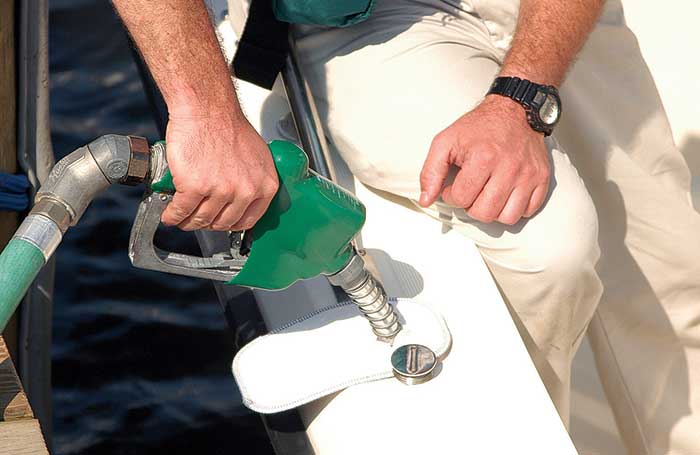Advertisement
This refresher explains how to avoid common mistakes during a routine process.

By following a few simple procedures, you can make fueling up safer for people and for the environment. (Photo: BoatUS Foundation)
Fueling up at the dock is a fact of life for many boaters, but even for seasoned skippers, it's easy to make mistakes and take things for granted. Here are some tips for preventing four common, and often costly, mishaps at the pump.
Do You Need Gas Or Diesel?
This is usually the first question you're asked at the dock, and there should be an obvious answer. But a marina manager in New Jersey told us that the number of people who put the wrong fuel into their boats would surprise you. "You wouldn't believe how many people pull up to the dock and say they need to 'gas up' when they need diesel fuel, or say they need 'fuel' when they mean 'gasoline,'" the manager says. Because of that, he instructs his staff to use three syllables to confirm the fuel of choice for each customer: Do you need gas-o-line or die-sel fuel? It may sound silly, but the next time the dock attendant passes you the nozzle, confirm which type of fuel you are receiving.
How Much Do You Need?
Knowing how much fuel you want helps the marina staff know when to be ready to assist. Boat fuel tanks are often irregularly shaped, making fuel gauges less accurate. When your fuel gauge reads one-quarter, how many gallons do you typically need? Spills can easily occur when the tank is more full than you thought and the nozzle doesn't stop in time.
What's Your Deck Fill?
When talking to marina managers, one of the most common fueling mishaps is putting the nozzle into the wrong deck fill. Water tanks and rod holders are surprisingly often mistaken for the fuel fill. For a boater who is multitasking at the fuel dock, dozens of gallons of fuel can end up in the water or in the bilge in just a matter of minutes, creating a dangerous situation. One marina manager calls this "a $5,000 mistake." Not only does that represent the cost of the fuel you put in the boat, and risk an explosion; you also have to pay for a spill responder to place foam in the bilge to prevent an explosion, move the boat away from the dock, remove the fuel, then clean the boat. All in all, that's an expensive day, and it's a place you don't want to put yourself.
Spills Are Serious Business
Any spill that creates a sheen on the water must be reported to the National Response Center at (800) 424-8802. Failure to report a spill or to mask a spill with soaps or other products can result in even greater fines. Did you know the BoatUS Foundation has a free online training course for marina staff to help them learn how to prevent spills? This training is designed to help marinas overcome the training challenges of high turnover and seasonal staff. Our hope is that better-trained marina staff will lead to a better experience for you as well as to cleaner water. Visit BoatUS.org/Spill-Prevention to access the training.
Small Spills
So you have the right fuel, you know how much you need, and you put the nozzle in the correct deck fill. Now you can sit back and relax, right? Not quite. Most gas docks don't have the convenient hands-free clip on the nozzle allowing you to pump mindlessly, and for good reason: They often don't click off in time. The venturi mechanism in a roadside gas pump works in closed fuel systems, as in a car. When fuel enters the tank, air is forced out at its opening as it's displaced by the fuel.
In boats, you have a vented fuel system. The vent allows air to escape so the automatic shutoff doesn't work as you'd expect. Take your time and pay attention, and while you're at it, keep a fuel-absorbent absorbent cloth with you to hold around the deck fill and vent in case any fuel burps out. Ask for one if you don't have one.
Follow basic fueling safety practices while fueling. Be sure all smoking materials are extinguished, and ask that all passengers move onto the dock. This is a good time to use the shoreside restrooms one last time or pick up some more bait from the marina store. With gasoline engines, be sure to run the blower for five minutes before starting the engine.
